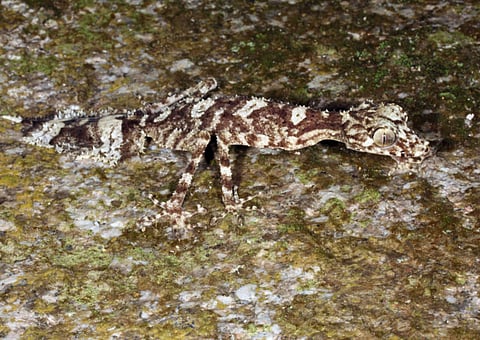‘Lost world’ discovered in remote Australia
Expedition uncovers new species isolated for millions of years

SYDNEY: An expedition to a remote part of northern Australia has uncovered three new vertebrate species isolated for millions of years, with scientists Monday calling the area a “lost world”.
Conrad Hoskin from James Cook University and a National Geographic film crew were dropped by helicopter onto the rugged Cape Melville mountain range on Cape York Peninsula earlier this year and were amazed at what they found.
It included a bizarre looking leaf-tail gecko, a gold-coloured skink - a type of lizard - and a brown-spotted, yellow boulder-dwelling frog, none of them ever seen before.
“The top of Cape Melville is a lost world. Finding these new species up there is the discovery of a lifetime - I’m still amazed and buzzing from it,” said Hoskin, a tropical biologist from the Queensland-based university.
“Finding three new, obviously distinct vertebrates would be surprising enough in somewhere poorly explored like New Guinea, let alone in Australia, a country we think we’ve explored pretty well.”
The virtually impassable mountain range is home to millions of black granite boulders the size of cars and houses piled hundreds of metres high, eroded in places after being thrust up through the earth millions of years ago.
While surveys had previously been conducted in the boulder-fields around the base of Cape Melville, a plateau of boulder-strewn rainforest on top, identified by satellite imagery, had remained largely unexplored, fortressed by massive boulder walls.
Within days of arriving, the team had discovered the three new species as well as a host of other interesting finds that Hoskins said may also be new to science.
The highlight was the leaf-tailed gecko, a “primitive-looking” 20 centimetre-long (7.9 inches) creature that is an ancient relic from a time when rainforest was more widespread in Australia.
The Cape Melville Leaf-tailed Gecko, which has huge eyes and a long, slender body, is highly distinct from its relatives and has been named Saltuarius eximius, Hoskin said, with the findings detailed in the latest edition of the international journal Zootaxa.
“The second I saw the gecko I knew it was a new species. Everything about it was obviously distinct,” he said.
Highly camouflaged, the geckos sit motionless, head-down, waiting to ambush passing insects and spiders.
The Cape Melville Shade Skink is also restricted to moist rocky rainforest on the plateau, and is highly distinct from its relatives, which are found in rainforests to the south.
Also discovered was a small boulder-dwelling frog, the Blotched Boulder-frog, which during the dry season lives deep in the labyrinth of the boulder-field where conditions are cool and moist, allowing female frogs to lay their eggs in wet cracks in the rocks.
In the absence of water, the tadpole develops within the egg and a fully formed frog hatches out.
Once the summer wet season begins the frogs emerge on the surface of the rocks to feed and breed in the rain.
Tim Laman, a National Geographic photographer and Harvard University researcher who joined Hoskin on the expedition, said he was stunned to know such undiscovered places remained.
“What’s really exciting about this expedition is that in a place like Australia, which people think is fairly well explored, there are still places like Cape Melville where there are all these species to discover,” he said.
“There’s still a big world out there to explore.”
According to National Geographic, the team plans to return to Cape Melville within months to search for more new species, including snails, spiders, and perhaps even small mammals.
“All the animals from Cape Melville are incredible just for their ability to persist for millions of years in the same area and not go extinct. It’s just mind-blowing,” Hoskin said.
Sign up for the Daily Briefing
Get the latest news and updates straight to your inbox



